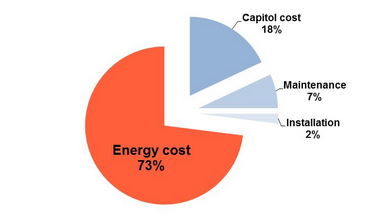Air can often be viewed as an unlimited resource with no associated costs. During an average compressor’s lifetime of around 10 years, the cost of compressed air is roughly divided up as 73% energy costs. The remaining 27% is divided between capital costs, installation and maintenance (see diagram).
In reality, producing 1 kW of compressed air requires 8 kW of electricity. So, if you’re not evaluating the energy performance of your system, you are potentially converting your money into thin air.


The above table lists the estimated amount of air leaking from a system (operating at a pressure of 700kPa for 2000 hours per year), the energy wasted, and its cost for an electricity tariff of 10c/kWh. Analysing one of the results in the table as an example, if the sum of all leaks is equivalent to a hole of 12.7mm diameter, 204.8 l/s of air is lost, wasting 136,192kWh of energy each year at a cost of $13,619.
Air leaks waste energy
There are a number of ways to measure your system’s efficiency; one way is evaluating your overall system design. In particular, investigating any pressure drops. Pressure drop refers to the drop in pressure between the compressor and end users. If you have a large pressure drop present, your system could prove to be very inefficient.
To compensate for any large pressure drop in your system, your compressor has to work overtime to supply the required air pressure. In fact, for every 10 psi in excess pressure your system produces, results in a 5% increase in power cost. Not only can an overworked compressor hurt your back pocket, but it can damage your equipment and increase the chance of leakage.
Leaks can waste up to 50% of the compressed air produced by the compressor in a typical industrial plant that is not well maintained.
But the expense doesn’t stop there; because leaks cause a drop in system pressure, air tools don’t work, adversely affecting production. Leaks also shorten the life of most equipment in a system (including the compressor itself), as leaks force the compressor to cycle more regularly. This means more maintenance, resulting in unscheduled downtime.
Common sources of air leaks
While leaks occur almost anywhere in the system, the most likely sources of the problem are:
- Couplings, hoses, tubes and fittings
- Pressure regulators
- Open condensate traps and shut-off valves; and
- Pipe joints, disconnects and thread sealants
How to find a leak in your compressed air system
Apart from listening for leaks, which can be deceptively unreliable in a noisy environment, there are two key ways to find compressed air leaks. The simplest is to brush soapy water on suspect areas and look for bubbling. This method is cheap but can be extremely time-consuming.
The best way to detect a leak is to use an ultrasonic acoustic detector to recognise the high-frequency hiss of escaping air. These portable devices consist of directional microphones, amplifiers and audio filters, and usually, have either earphones or visual indicators to detect leaks. This means that they can operate in noisy plant environments, so equipment does not have to be turned off.
When it comes to fixing leaks, however, nothing beats a comprehensive leak prevention program with identification, tracking, repair and verification.
Book an air audit with NPS
To ensure you are not spending more than you need to, our experienced service technicians can perform an efficiency air audit on your system. Our audit involves a comprehensive report, with recommendations for a scope of work to improve your running costs. Call us on 1300 290 638 for more information.


